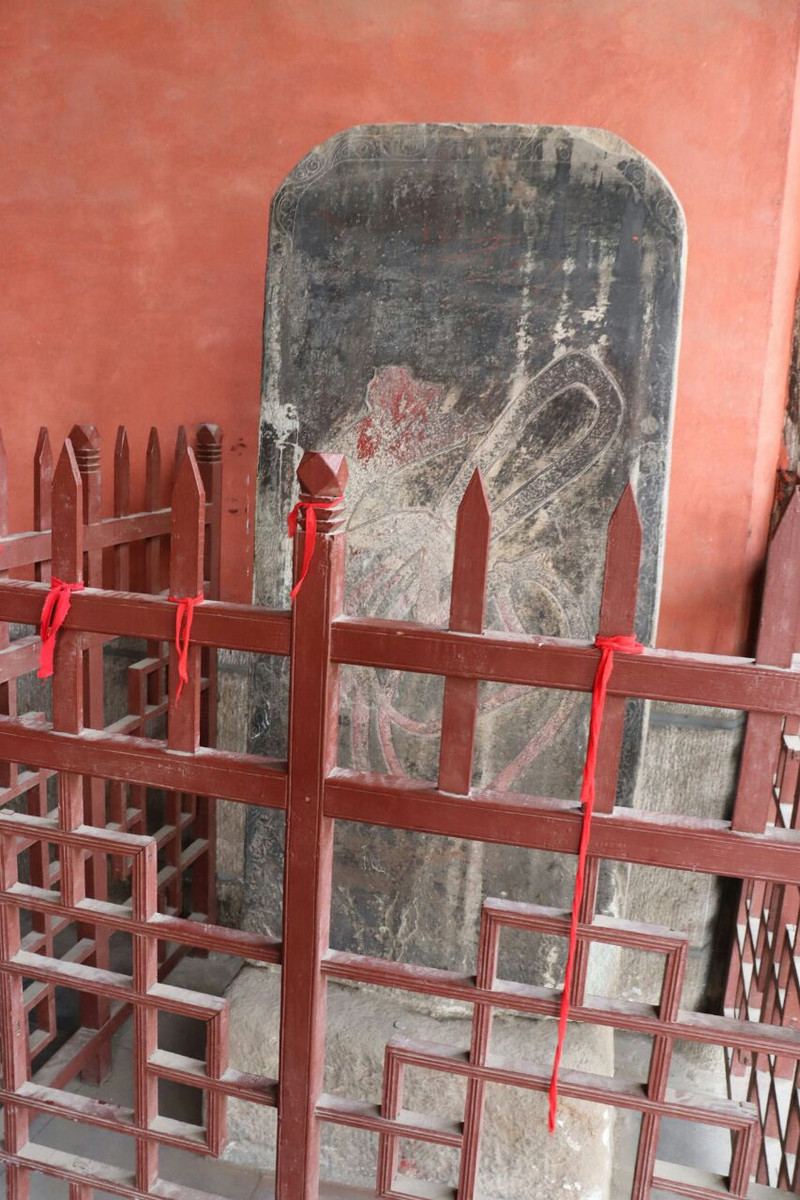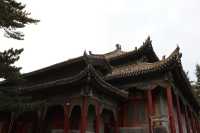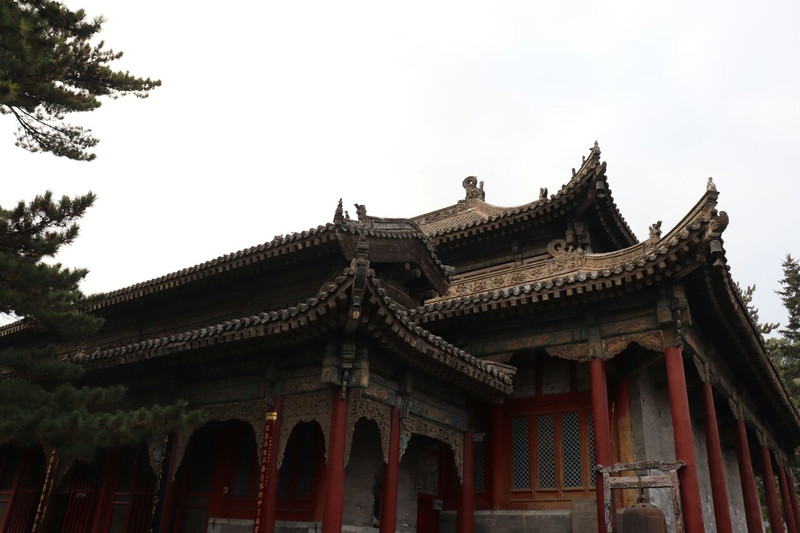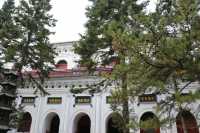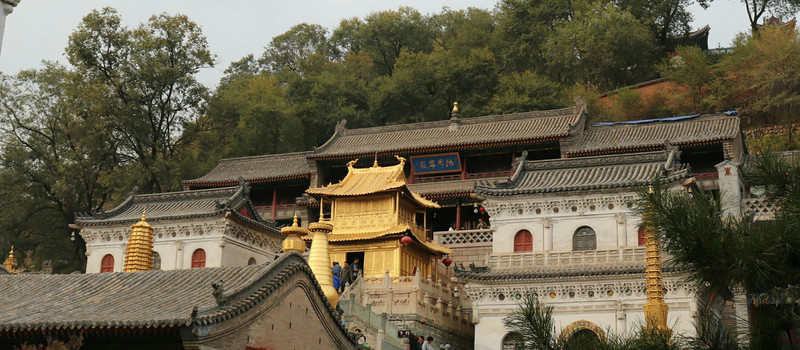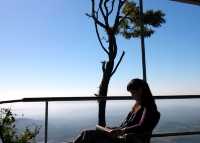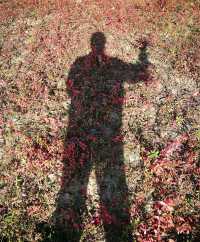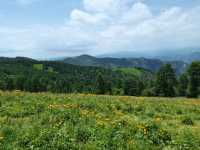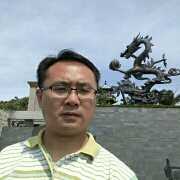The pagoda temple comes out and walks along an expanding path. On the right is the Luo Yin temple, and on the right is the Yuanzhao temple. Opposite the Luoyan Temple, walk to the left and you will come to Xiantong Temple. Xiantong Temple, formerly known as Dafu Lingjiu Temple, always feels that some sections of the eight bridges of Tianlong are just like here. Xiantong Temple is the first Buddhist monastery in Wutai Mountain, which was built in the Eastern Han Dynasty. After the completion of Baima Temple, two eminent monks from Luoyang came to Wutaishan and built the temple, named Dafu Linglu Temple, which is called "the Second Ancient Temple of China" and is one of the earliest temples in China. On the central axis of the temple, the seven-fold halls are divided into Guanyin Hall, Wenshu Hall, Great Buddha Hall, Wuliangdian, Qianbo Hall, Tongdian and Tibetan Sutra Hall, each with its own characteristics. More striking is this infinite hall, in a gray and black tiles as red pillars and green bricks of the ancient building complex, a white exterior wall straight line square building is still very eye-catching. Architecture is divided into two floors, seven bright and three dark. It is a masterpiece of ancient Chinese brick and stone architecture art. According to the introduction, the architectural style is a combination of China and the West, and some details of foreign schools have been used for reference to try to apply in the traditional style. The "Huayan Jing" pyramid preserved in the hall is a rare treasure, which was written by Suzhou people in twelve years. The brightest one is this golden bronze hall. Ming Wanli (1609 A.D.) Miaofeng monk, a collection of 13 provinces and cities throughout the country, has been cast into three copper halls, one set Emei Mountain, one set Baohua Mountain in Nanjing, one set Wutai Mountain. The three copper halls were cast in Jingzhou, Hubei Province, and then shipped to the site for assembly. Now there is only one in Wutaishan, which is made of 100,000 Jin of copper. In front of the Tongdian Hall, there were five copper towers cast at the same time, which were arranged according to the east, west, north, South and middle directions. Unfortunately, three of them were stolen by the island state, and only two of them were still in existence. No wonder the copper hall and pagoda are decorated with gold foil. As for Miaofeng monk, why is he so capable? It seems that he is a master of the Royal family. Therefore, not everyone can easily make hundreds of thousands of Jin of copper by relying on Dashu to do things well.
;
Xiantong Temple Review
4.8 /5181 Reviews
Xiantong Temple Frequently Asked Questions
More Questions
Jeremy_Dodson: I recommended Dailuoding,Wuye Temple,Pusa Ding (Bodhisattva Top),Xiantong Temple,Pagoda Temple
1 Answer
Messiah_Dillon: Here are some hotels near Xiantong Temple: Huibinlou Hotel,Wu Tai Moutain Friendship Hotel,QIXIANGE GUEST HOTEL,,
1 Answer
Judah_Dillard: You could try ,,Yonghongtieguodian (difangtesetieguoduncai),Beiyue Local Restaurant,
1 Answer
Popular Destinations
Kyoto Travel | Lanzhou Travel | Hat Yai Travel | Doha Travel | Seoul Travel | Jakarta Travel | Potenza Travel | Haikou Travel | Hong Kong Travel | Taoyuan Travel | Venice Travel | Surat Thani Travel | Vernier Travel | Miyako Travel | Philippines Travel | Baler Travel | La Trinidad Travel | Srinagar Travel | Guiyang Travel | Satun Travel | Genthin Travel | Vivsya Travel | Champagne Travel | Champeguano Travel | Adams Travel | Mangli Travel | Hawthorn East Travel | Goschen Travel | Dresbach Township Travel | Beyr Oulad Issa Travel
Recommended Attractions at Popular Destinations
Bangkok attraction near me | Tokyo attraction near me | Manila attraction near me | Hong Kong attraction near me | Taipei attraction near me | Seoul attraction near me | Los Angeles attraction near me | New York attraction near me | Shanghai attraction near me | Kuala Lumpur attraction near me | Shenzhen attraction near me | Osaka attraction near me | Singapore attraction near me | London attraction near me | Guangzhou attraction near me | San Francisco attraction near me | Beijing attraction near me | Macau attraction near me | Bali attraction near me | Paris attraction near me | Ho Chi Minh City attraction near me | Orlando attraction near me | Jakarta attraction near me | Chicago attraction near me | Phuket attraction near me | Toronto attraction near me | Istanbul attraction near me | Dallas attraction near me | Cebu attraction near me | Seattle attraction near me
Popular Attractions
Water Cube (National Aquatics Center) | The West Lake | SM MOA Eye | Shanghai Wild Animal Park | Yuanmingyuan Park | Grand Tang Dynasty Ever-bright City | Oriental Pearl Radio & Television Tower | Manila Ocean Park | The Roman Forum | Neuschwanstein Castle | Cliff village | Universal Studios Singapore | The Sanctuary of Truth | Aquaria Phuket | Seine River Cruise | Zhouzhuang | Yulin West Road | Jingshan Park | Chinese Dinosaur Park | Chimelong Paradise | Tang Paradise | Asiatique Sky | 1933 Old Millfun | Coron Island | Impression West Lake | Studio City Water Park | Qijiang Guojia Dizhi Gongyuan Laoying Mountain Sceneic Area | Dun Caan | Traccion A Sangre | Monte Panarotta
Popular Travelogues
Bangkok Travelogue | Tokyo Travelogue | Manila Travelogue | Hong Kong Travelogue | Taipei Travelogue | Seoul Travelogue | Los Angeles Travelogue | New York Travelogue | Shanghai Travelogue | Kuala Lumpur Travelogue | Shenzhen Travelogue | Osaka Travelogue | Singapore Travelogue | London Travelogue | Guangzhou Travelogue | San Francisco Travelogue | Beijing Travelogue | Macau Travelogue | Bali Travelogue | Paris Travelogue | Ho Chi Minh City Travelogue | Orlando Travelogue | Jakarta Travelogue | Chicago Travelogue | Phuket Travelogue | Toronto Travelogue | Istanbul Travelogue | Dallas Travelogue | Cebu Travelogue | Seattle Travelogue
Payment Methods
Our Partners
Copyright © 2024 Trip.com Travel Singapore Pte. Ltd. All rights reserved
Site Operator: Trip.com Travel Singapore Pte. Ltd.
Site Operator: Trip.com Travel Singapore Pte. Ltd.



